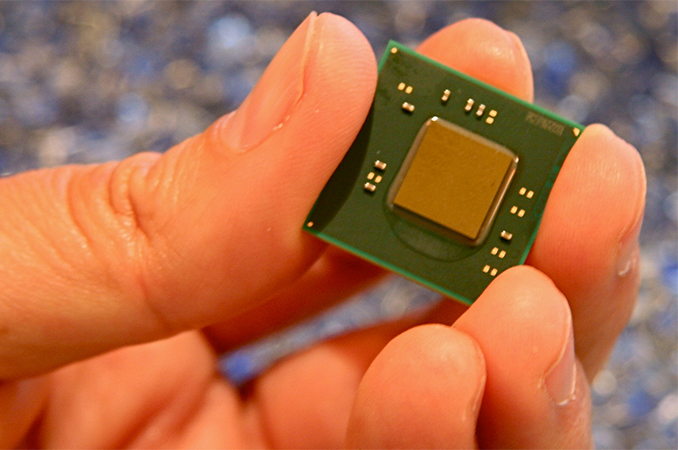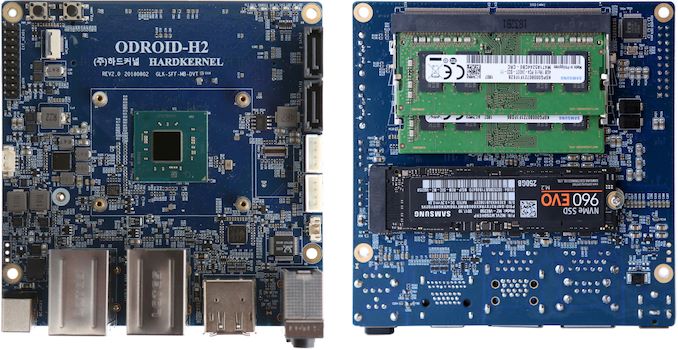Short Supply of Intel’s Gemini Lake Confirmed by PC Maker
by Anton Shilov on November 21, 2018 11:35 AM EST- Posted in
- SoCs
- CPUs
- Intel
- Gemini Lake
- Hardkernel
- Odroid

Intel has publicly admitted that demand for its processors exceeds supply, which is why it is currently prioritizes shipments of its higher-end Core and Xeon products over cheaper chips. Various manufacturers of actual PCs are now confirming the backlog in orders, giving us additional details to the story. As it appears, shortages of Intel’s Gemini Lake SoCs for low-cost PCs are so severe that the earliest opportunity for some of the PC makers to get the chips will be in February or March.
Earlier this week a company named Hardkernel launched its first x86-based Odroid-H2 compact PC platform, a device akin to a Raspberry Pi. The 4.3 inch × 4.3 inch platform is based on Intel’s quad-core Celeron J4105 SoC and can be equipped with up to 32 GB of DDR4-2400 memory, an M.2 SSD, and has an essential set of wired I/O interfaces (DP 1.2, HDMI 2.0, two GbE ports, two USB 3.0, two USB 2.0, 3.5-mm audio jack, and an S/PDIF).
The launch was labeled a success and the first batch of 2,000 units was sold in 24 hours. As it appears, the company did not expect demand to be so high, so it did not prepare more units. Apparently, Hardkernel cannot order more Gemini Lake SoCs from Intel right now. The chip giant reportedly said that it would be able to deliver the chips in February or March, but could only provide a more exact delivery schedule in January.
“We have very small problem now,” the company said “We have sold out all our first production lot in 24 hours. We are so sorry for that. In fact, we conservatively prepared only 2,000pcs of H2 boards because we could not predict this situation. We are contacting Intel for the lead time of the Gemini Lake processor. Due to Intel's serious supplying issue these days, they can supply the Gemini Lake SoC in February or March 2019. […] They also mentioned that they can give us a firm delivery schedule in January.”
Considering the fact that Gemini Lake is an entry-level product, it is not surprising that it sits rather low in Intel’s list of priorities. In fact, a rumor has it that Intel is considering to outsource some of its low-end SoCs to contract makers of semiconductors, though considering all the complexities with re-spinning the chips for someone else’s process technology, this is something that will be a hard thing to do.
One thing that particularly attracts attention is the volume of SoCs that Hardkernel might require. The first batch was only 2,000, so it is unlikely that the second batch would hit 20,000. Meanwhile, Intel does not seem to have spare Gemini Lake SoCs at all, which once again emphasizes the scope of the company’s problems.
Related Reading
- ASUS Comments on Intel Shortages, U.S.-China Trade War
- Intel Investing $1B to Meet 14nm Demand: Prioritizing High-End Core and Xeon
- Intel Announces Q3 FY 2018 Earnings: Record Quarter
- Intel to Split Manufacturing Group into Three Segments
Source: Hardkernel (via FanlessTech)












26 Comments
View All Comments
edzieba - Wednesday, November 21, 2018 - link
"One thing that particularly attracts attention is the volume of SoCs that Hardkernel might require. The first batch was only 2,000, so it is unlikely that the second batch would hit 20,000. Meanwhile, Intel does not seem to have spare Gemini Lake SoCs at all, which once again emphasizes the scope of the company’s problems."Very small order sizes counts against availability. If you're ordering 20,000 (or 200,000) chips, then that's enough that you can schedule a production batch just for that order. For a piddling thousand or two, that means you need to wait for a large enough order (or a large collection of smaller orders) to come in to piggyback that small batch onto, or it does not make sense to shift a line over to that chip - for the little Gemini Lake dies, that's about 4 wafers.
iwod - Wednesday, November 21, 2018 - link
It is not about small volume, it is Intel's prioritising Enterprise and high margin demand over anything else ( As they will be fighting against EPYC 2 ) and their capacity planning as well as 10nm has been behind schedule. These SoC are at the lowest priority.HStewart - Wednesday, November 21, 2018 - link
I would expect the volume of these chips to be low - the chip is basically the modern day Atom chip in designed. I have an older Lenovo IdeaPad 200 and it pretty much useless - part of that maybe only 2G memory - with 4G or 8G on this chip it could be better.But with just web browsing and email, you really don't need much.
digitalgriffin - Tuesday, November 27, 2018 - link
These chips have improved CONSIDERABLY in speed. This is especially true of the graphics. They are nipping at the heels of i3 U' models.piyush1123 - Monday, December 3, 2018 - link
Such a Great Thing!https://www.supplier-in-china.com/
Slangefar - Wednesday, November 21, 2018 - link
Rather silly it do not use Intel NICs. If it used Intel NIC it could be used easy with PFsense as router.Eletriarnation - Wednesday, November 21, 2018 - link
You could still use it with iptables and do fine, I had a similar ITX board from ASRock and was able to get gigabit routing out of it.peevee - Wednesday, November 21, 2018 - link
"and can be equipped with up to 32 GB of DDR4-2400 memory"Intel says it is max 8GB:
https://ark.intel.com/products/128989/Intel-Celero...
Anyway, they were able to fit 2 SODIM slots into this thing. How the hell much larger ITX boards have only 2 as well?
Brahman05 - Wednesday, November 21, 2018 - link
It's the nature of memory channels. The way this board does it the lookup table has to be completely in ram. On a modern dual channel cpu 32GB is theoretical max. You CAN add up to 64GB id it splits each channel, like on a normal atx mobo, but it comes with a performance penalty. As ram standards get faster and faster that penalty is less but still there. It used to matter more as recently as amd piledriver, bulldozer ddr3, and even more with ddr2 etc, but with a 4.5Ghz cpu and ddr4-3000 machine that penalty is meh enough its barely even mentioned. My fancy Laptop has 4 sodimm's so i could use 64GB if i really needed that much but I don't so I went with a lirtle faster 16GBx2 for 32GB and to be honest, with that modern system i was actually morw worried about power draw. Ram has to be on to work so even empty ram draws power, that performance hit didn't really worry me, now if they start selling a ddr4-2800 and up kit.....PixyMisa - Wednesday, November 21, 2018 - link
A number of users have reported success running these CPUs with 16GB and 32GB of RAM. I'm not sue why Intel still says the max is 8GB.